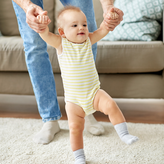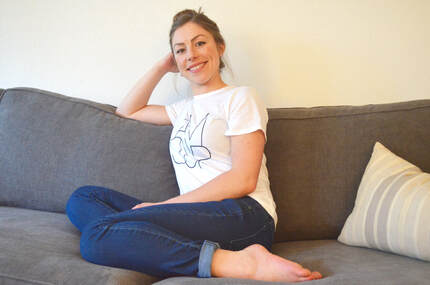 Today's society imparts the feeling that a child's motor skills must advance as quickly as possible. Doctors prescribe tummy time before a child can roll to their belly; we "walk" our children by holding their hands above their heads before they stand on their own; we carry babies in an upright position before they can hold their head atop a straight back. Here is why I think we should take a moment to consider an alternative to this conventional wisdom. Each child's development is directed by an internal timetable and innate impulses, contingent on the neuro-motor foundation already built. That foundation is established by independence and ownership over gross motor development, not by adult interference.
A child who is afforded the opportunity to learn on his/her own will instinctively develop the coordination, body awareness, flexibility, balance, and anti-gravity mechanism needed to achieve each next milestone. The infant who is allowed ample time on his/her back will learn how to form recognizable patterns out of random movements, discovering "tummy time" on his/her own, and figuring out how to roll back. The experience of a child's own uninterrupted movement will help build a keen awareness of physical capabilities, laying a much stronger framework for organizing more advanced actions than a child who was "taught" how to move. The benefits of giving a child freedom and control over his/her own development expand far beyond physical skills. This experience is also monumental for a child's self-confidence, gaining self-assurance when each new skill is initiated and engineered by the child. Working through challenges autonomously supports development of frustration tolerance and problem solving skills. Not to mention the joy and sense of pride when observing your child persevere to overcome physical challenges and discover and master new forms of mobility on their own. For the child with physical limitations, we are quicker to interfere and project milestones even further ahead of current functioning. We use braces, standers, and walkers on the bodies of kids who are still figuring out how to hold their head up, roll over, come up to sit, or stay "up." Instead of providing conditions to help fill in the missing pieces, we provide a false sense of security thinking it may speed up the process. On a neurological level, that ends up teaching the brain the system is unfit for the job. Now, there may be some (limited) occasions to use equipment like this. But, there are many more reasons to meet a child where they are at to help the brain develop a musculoskeletal infrastructure that supports motor learning. Here are five ways we can do that, for both the typically developing or developmentally delayed child: 1. Put the developmental milestone chart away: Stop comparing, stop projecting your expectations. Every child is different, and development may not be linear. Let your child develop and learn at their own rate. Earlier does not mean better, smarter, or more coordinated. Delayed does not mean they will never catch up. Focus on the quality of your child's movement. That is what builds a foundation for learning, success, and intelligence. 2. Don't rush through important stages: Let your child explore within the realm of ease and ability; let them do their natural homework. Provide opportunities for your child to build on what they already know, allowing them to make mistakes along the way. The average 2 year old falls 38 times a day, each one a learning and practice opportunity. Be patient and trust the process. 3. Move slowly to allow the child to truly feel and experience: Feeling is everything; we learn kinesthetically. As you pick up your child, help them get dressed, or assist them during meal time, take things slow. Plan ahead and set aside time to truly immerse your child in the sensory experience of how their body, and your body, moves. Awareness stems from that. 4. Skip the gadgets: Equipment or the latest baby product do not make kids stronger, faster, or smarter any sooner. The neuromuscular system develops from top to bottom, midline to fingertips. Babies gain head control, then control of the trunk for sitting, and coordination of the limbs for mobility. Special equipment, toys, or tools do not speed up, correct, or skip steps in this process. 5. Eliminate activities that trap the child's brain and body: A child who can't get into a position by themselves should not be placed there. A child who cannot hold their head up should not be put in a stander. In these situations, the brain won't know what to do and it will learn its limitation. Instead, meet your child at their current functioning level and choose activities with a "just right challenge" within a familiar context. Child development is a huge source of anxiety for parents. We are told to follow an artificial calendar outlining the path of milestones, and get worried when the date and skill don't match. So, we interfere in hopes the child stays "on track." But the reality is that children arrive at each step at different times, depending on their unique inborn timetable and how much autonomy or interference they have had along the way. So, instead of "teaching" your child to walk by holding their hands above their head (is that how we walk, anyway?), foster your child's inner drive and encourage self-initiated learning experiences. That is what will support them for a life of upright movement!
0 Comments
Your comment will be posted after it is approved.
Leave a Reply. |
meet the bloggerAusten is a pediatric occupational therapist with experience in schools, early intervention, and private clinic settings. She now runs her own private practice in Portland, OR specializing in movement based learning techniques. This blog's mission is to educate and empower parents and children by sharing insights into the complexities of learning and development. Categories
All
|
MINDFUL MOVEMENT THERAPIES
In-Home Pediatric Occupational Therapy in Portland, Oregon
phone503-720-4634
|
|
|

